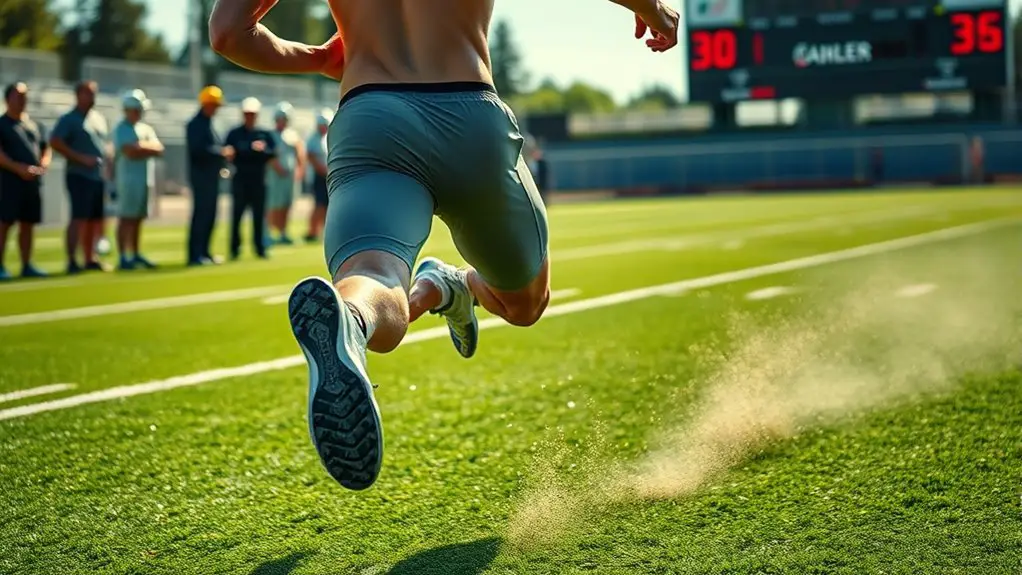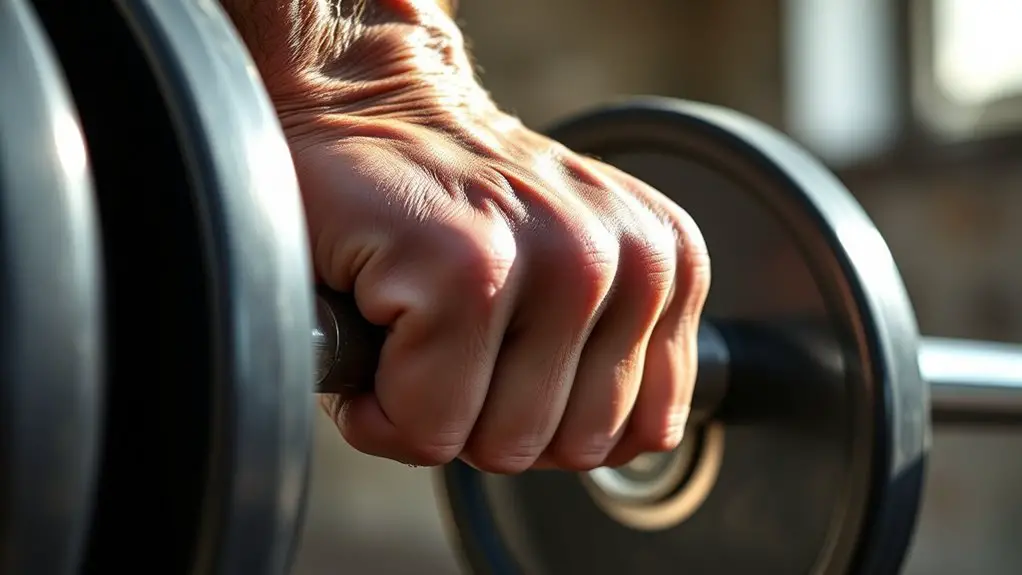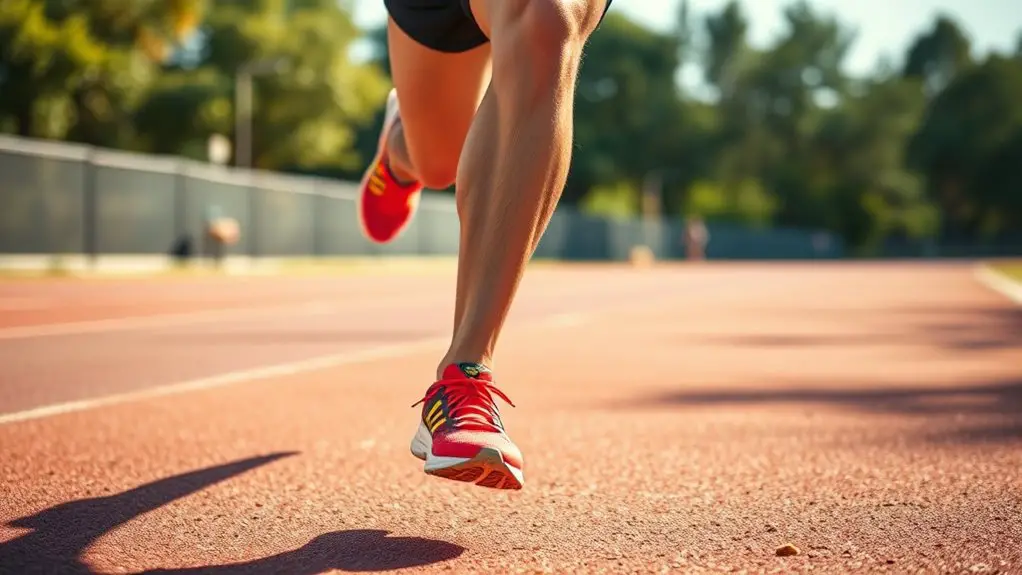To achieve explosive cuts as a running back, strengthening your hips is essential. Focus on key muscles like the glutes, hip flexors, and adductors. Incorporate exercises like squats, lunges, and clamshells into your routine to build strength. Don't forget mobility work; dynamic stretching and hip circles enhance flexibility and prepare your joints for sharp movements. Prioritizing hip strength not only boosts performance but also helps prevent injuries. There's more to learn about crafting an effective hip-strengthening program.
Understanding the Importance of Hip Strength in Running Backs
When you think about running backs, their speed and agility often come to mind, but the foundation of these qualities lies in their hip strength. Strong hips enable you to execute explosive movements, allowing you to change direction quickly and break free from defenders. Understanding hip biomechanics is essential; your hips serve as the powerhouse for generating force and maintaining balance while you sprint.
When you harness your hip strength, you release the potential for greater acceleration and powerful cuts on the field. It's not just about running fast; it's about controlling your body and making those sharp turns that leave defenders in the dust. By focusing on strengthening your hips, you're not just improving your game; you're embracing the freedom to express your athleticism. Incorporating compound movements in your training will further enhance your hip strength and overall performance. So, prioritize hip strength in your training, and watch how it transforms your performance on the field.
Key Muscles Involved in Hip Movement
Understanding the key muscles involved in hip movement is essential for any runner looking to enhance performance and reduce injury risk. The hip area plays a significant role in your ability to cut and accelerate, so knowing these muscles can help you release your potential.
| Muscle Group | Function | Importance |
|---|---|---|
| Glutes | Hip extension, rotation | Glute activation boosts power and stability. |
| Hip Flexors | Hip flexion | Vital for quick leg lifts and accelerating. |
| Adductors | Leg stabilization | Helps control lateral movements. |
| Quadriceps | Knee extension | Supports powerful strides and support during cuts. |
Additionally, strong posterior chain muscles can significantly enhance your cutting ability and overall athletic performance.
Effective Exercises to Strengthen the Hips
Strengthening the hip muscles you've just learned about is essential for improving your running performance and minimizing injury risk. You can start with bodyweight drills like squats and lunges, which engage multiple muscle groups while focusing on your hips. These exercises not only build strength but also enhance stability and balance.
Incorporating resistance bands can take your workouts to the next level. Try lateral band walks to activate your hip abductors, or perform clamshells to target the glutes effectively. These movements help develop the explosive power needed for quick cuts and changes in direction on the field. Additionally, prioritizing flexibility and mobility in your routine can further enhance joint function and decrease injury risk.
Consistency is key, so aim to include these exercises in your routine a few times a week. With determination and the right exercises, you'll feel freer and more agile during your runs, making every cut feel effortless.
Incorporating Mobility Work for Optimal Performance
To enhance your running performance, incorporating mobility work is just as essential as building strength. Mobility drills can free up your hips, allowing for smoother and more explosive cuts on the field. Think of dynamic stretching as your pre-game ritual; it warms up your muscles and prepares your joints for the demands of the game.
Start with leg swings, hip circles, and lunges to activate your hip flexors and glutes. These movements not only increase your range of motion but also improve your overall coordination, making you a more agile runner.
Don't underestimate the power of a good warm-up. By focusing on mobility, you'll feel lighter and more flexible, giving you the freedom to make those sharp turns without hesitation. Incorporating these practices into your routine will help you unleash your full potential and elevate your game, as enhanced flexibility significantly improves muscle efficiency and reduces energy expenditure.
Injury Prevention Through Hip Strengthening
Hip stability plays an essential role in preventing injuries while running. By incorporating targeted exercises, you can strengthen your hips and reduce the risk of strains or overuse injuries. Let's explore how focusing on hip strength can keep you running safely and efficiently. Additionally, enhancing proprioceptive abilities can significantly contribute to better balance and coordination, further minimizing injury risks during dynamic movements.
Importance of Hip Stability
While many runners focus on building endurance and speed, neglecting hip stability can lead to injuries that sideline you. The hip joint is essential for your overall performance, and maintaining dynamic stability is key to avoiding setbacks. Here's why hip stability matters:
- Injury Prevention: A strong, stable hip joint reduces the risk of strains and tears during explosive movements.
- Enhanced Performance: Stability allows for quicker, more controlled cuts, improving your agility on the field.
- Balanced Mechanics: Proper hip strength promotes better alignment and movement patterns, reducing stress on your knees and lower back.
Exercises for Injury Prevention
Strengthening your hips can greatly reduce the risk of injuries that often plague runners. By focusing on exercises that promote hip strength and core stability, you can enhance your overall performance and enjoy the freedom of movement. Incorporate dynamic stretches like leg swings and hip circles into your warm-up routine to prepare your muscles for action. Additionally, try exercises such as clamshells, bridges, and lateral band walks to target those vital hip muscles. These movements not only build strength but also improve flexibility, making you more resilient during explosive cuts and sprints. Commit to a balanced routine that emphasizes both strength and stability, and you'll find yourself running with confidence, free from the fear of injury.
Developing a Balanced Training Regimen for Running Backs
To excel as a running back, you need a balanced training regimen that targets strength, agility, and endurance. This approach will not only enhance your performance but also keep you injury-free. Here's how to create a well-rounded plan:
- Strength Training: Focus on lower body exercises like squats and lunges to build powerful legs and hips.
- Agility Drills: Incorporate cone drills and ladder exercises to improve your footwork and quick cuts.
- Endurance Work: Don't forget about cardio! Running longer distances will help you maintain energy during games.
In addition to physical training, prioritize balanced nutrition to fuel your body and enhance recovery. Finally, cultivate mental focus through visualization techniques and mindfulness exercises. This holistic approach guarantees you're not just physically prepared but also mentally sharp, ready to take on any challenge thrown your way. Incorporating strength workouts into your routine can significantly improve your overall performance on the field.
Frequently Asked Questions
How Often Should I Train My Hip Strength for Optimal Performance?
Did you know that athletes who train their hip strength at least three times a week can improve their performance by up to 20%? For ideal performance, aim for a training frequency of three to four sessions weekly. Just remember, recovery time is essential; don't underestimate rest days. Balance your workouts with proper recovery to keep your hips strong and flexible, giving you the freedom to move explosively and efficiently on the field.
Can I Strengthen My Hips Without Gym Equipment?
Absolutely, you can strengthen your hips without gym equipment! Bodyweight exercises like squats, lunges, and glute bridges are fantastic for building strength. You can also incorporate mobility drills such as leg swings and hip circles to enhance flexibility and range of motion. This freedom to train anywhere means you're not limited by gym access. Just find a comfortable space, and you're ready to go! Embrace the process, and your hips will thank you!
What Are the Signs of Hip Weakness in Athletes?
If you're wondering about signs of hip weakness in athletes, pay attention to any hip pain you might experience during or after activity. You may also notice muscle imbalances, where one side feels markedly weaker than the other. This can lead to compromised performance and increased risk of injury. If you're feeling less agile or struggling with movements that once felt easy, it might be time to address those hip issues for more freedom in your athletic pursuits.
How Does Nutrition Impact Hip Strength and Performance?
When it comes to nutrition, you can't judge a book by its cover. Nutrient timing plays a vital role in how well your body can repair and strengthen muscles, including your hips. Consuming adequate protein sources, like lean meats or plant-based options, right after a workout can help you recover faster and build strength. Prioritizing balanced meals fuels your performance, giving you the freedom to push limits and achieve your fitness goals.
Are There Age Considerations for Hip Strengthening Exercises?
When thinking about age considerations for hip strengthening exercises, it's important to recognize that youth training often focuses on developing foundational strength. Younger athletes usually recover faster and can handle more intense workouts. In contrast, senior considerations require a gentler approach, emphasizing flexibility and stability to prevent injuries. Regardless of age, it's essential to listen to your body and adapt exercises accordingly, ensuring you maintain freedom of movement throughout your training journey.




